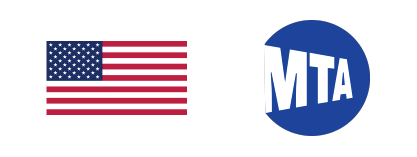NYC Subway Ridership
This is an interactive web map of the New York City subway system.
The data displayed shows average weekday ridership numbers across the entire city
from 2015-2020. 2020 saw a massive dip in ridership as the COVID-19 pandemic kept
many commuters at home throughout the year. Times Square/42nd street, NYC’s busiest
station, saw a 68.7% decrease in ridership as a result. In 2019 there was an average of
205,159 riders per weekday, but in 2020 the average fell to 64,301. Grand Central
Station/42nd Street, NYC’s second busiest station saw a similar pattern, decreasing 71.5%
from 2019 to 2020. In 2019 there was an average of 157,273 riders per weekday, and in 2020
the average fell to 44,778. One notable insight is the difference in weekday and weekend ridership levels
before and after the pandemic. Prior to the pandemic, weekends tended to be busier for the subways than weekdays for most stations.
However, during the pandemic (2020) this pattern is relatively inverted due to lockdowns leading people to go out more for work than recreation.
The New York City Subway system is not only one of the largest in the world, but also one of the
oldest, having opened its first line in 1904. Today, the subway comprises 472 stations, making it
the most extensive public transportation system in the United States. The subway initially consisted
of a single line, but it quickly grew to cover the entire city, providing residents with a fast and
efficient means of transportation. Over the years, the subway has faced numerous challenges, including
severe financial difficulties, aging infrastructure, and natural disasters such as Hurricane Sandy in 2012.
Despite these challenges, the subway continues to operate 24/7 and serves millions of passengers each day.
Some interesting facts about the New York City Subway include its use as a filming location for countless
movies and TV shows, the presence of abandoned stations and tunnels that have been repurposed or remain unused,
and the unique tile artwork and mosaics found in many stations.
The census tracts are ranked by calculating the distance between the centroid the of each polygon, and the their nearest subway station.
Mapped by Luke Casesa and Logan DeMars - Geography 575
Sources:
Subway Line and Station Data — NYC Open Data Portal
Subway Ridership Data — MTA Subway and bus ridership 2020
Census Tract Data — NYC Department of Planning Census Data Portal
Census Data — NYC Department of Planning Census 2020 Data

